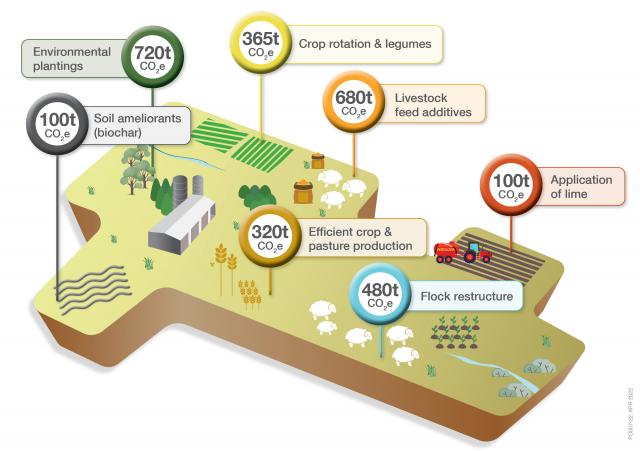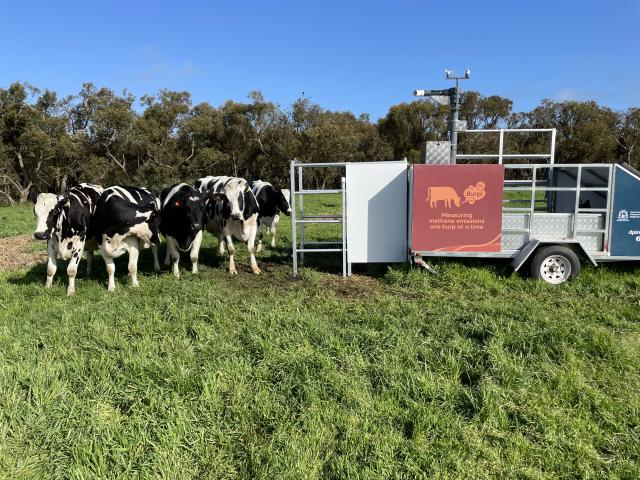DPIRD identified the Katanning Research Station (KRS) as a significant greenhouse gas (GHG) emitter, offering the opportunity to better understand the emissions arising from agriculture, and particularly livestock production. This demonstration project contributes to the West Australian Government’s commitment to emissions reduction and the sustainable mitigation of climate change.
DPIRD developed a strategy focussed on practical techniques and methods for mitigating greenhouse gas emissions from the livestock industry in Western Australia (WA). The strategy has two specific aims:
- To lower net emissions from DPIRD’s Katanning Research Station and achieve carbon neutrality on-farm by 2030, and
- Utilise the Katanning Research Station as a practical demonstration site to provide and support the application of tested carbon-neutral options for Western Australian broadacre farmers.
The baseline emissions and reduction plan for KRS was devised in 2020. The methodology, opportunities and progress of work undertaken from 2020-2023 can be found on the next page.
Planned works 2024-2026
Research, development and adoption (RD&A) for emissions mitigation, both on the station and in broadacre agriculture activities will be the focus over the next couple of years. The following works are in the design stage planned for 2024-2026
- Enteric methane research
- Revegetation and Agroforestry
- Implementing the Energy Audit recommendation
Livestock methane research
Ruminant livestock emit significant amounts of methane. DPIRD has undertaken a significant investment in the purchase of five GreenFeed machines to measure sheep and cattle methane emissions in the paddock. This technology enables researchers to explore emissions related to different feed types such as Lupins, Biserrula, and Saltbush.. The GreenFeed technology, developed by C-Lock in the United States of America, serves as an in-paddock measurement tool for ruminant animals.
Trials commencing in early 2024:
• Comparing GreenFeed methane data with methane data from Portable Accumulation Chambers (PAC) at the Katanning Research StationU
• Annual methane profile of sheep in southern agricultural systems at the Katanning Research Station – sheep grazing winter annual pastures, high legume spring pastures, cereal stubble, autumn pastures with grain supplementation
Initially, all four sheep machines will be at the Katanning Research Station, with future projects in the design phase. The availability of four machines enables concurrent trials, including the baseline sheep emissions measurement for a standard sheep system. We are further designing trials to compare emissions related to different feed types such as Lupins, Biserrula, and Saltbush in order to understand the unique feed systems used in WA.
Revegetation and Agroforestry
Over the upcoming years, there are plans to introduce a variety of trees and shrubs to both the marginal and some arable sections of the farm. In August 2023, the team conducted a farm audit, pinpointing potentially suitable locations for agroforestry, habitat creation, and infill areas. This audit revealed the potential for up to 195 hectares of new plantings.
Collaborating with consultants and industry experts, we will carefully choose species well-suited to the various soil types and intended purposes. Currently, our focus centres on protecting and enhancing existing vegetation, planting areas that are non-arable or not suitable for grazing or cropping, enhancing shade and shelter, and protecting areas at risk of salinity. the opportunities around plantings that support a woody biomass for renewable energy industries.
Energy Audit Recommendations
The overall energy usage across the entire DPIRD Katanning Research Centre is relatively low and represents a small part of the operating cost and carbon account. There are some simple opportunities to reduce emissions and costs.
DPIRD has the opportunity to invest $132k into energy efficiency and solar supply onsite, reducing the energy costs from $24k to $0 p/a.
The financial benefit accrues annually for the life of the project, in this case, 25 years, accumulating $590,000 of avoided energy costs for an establishment cost of $132,000.
Energy efficiencies focus on:
- Lighting - Replace old inefficient lighting across all buildings.
- Heating and cooling - Insulate site, including all external mechanical plant and pipes.
Energy supply opportunities:
Installation of rooftop solar arrays, designed to match baseline power usage will cost $118,500 for 72.5 kW with a cost reduction of $18,450 per annum, with a payback period of seven years.


